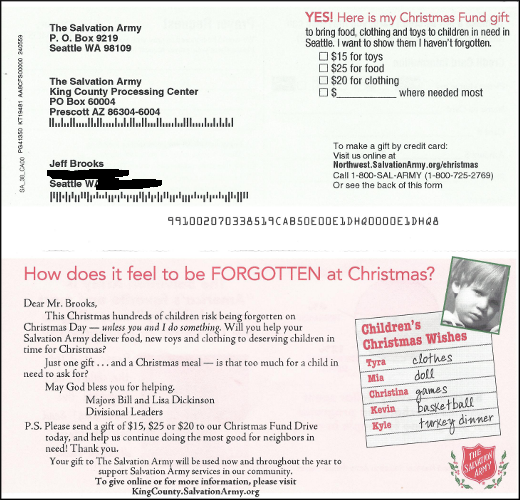Want to stir up a group of professionals? Want to see them sweat and wave their arms and cuss?
There’s one issue that will do it every time. I’m not talking about “poverty porn,” and it’s not the overhead controversy.
The big deal that really stirs people up is the odd truth that in fundraising, long messages almost always work better than short ones.
It’s not true 100% of the time, but it’s one of the most dependable truths in direct marketing — fundraising and otherwise. Want better results? Increase the length of the message.
Whenever I say this in public, a forest of hands goes up. How could that possibly be true? It must be an isolated incident! No way!
But don’t believe just me. Ask anyone with experience — especially testing experience — and they’ll confirm it. Long messages do better than short ones. Most of the time, as in about 80% of tests.
In The Fundraisingology Lab (an awesome private group just for members), a member recently posted this:
Director of PR just emailed me about my next letter draft (not even two full pages), she suggested it should never be longer than a page/one side. She suggested editing it down before sending it to the President.
It’s a distressingly common situation: Someone with no experience in fundraising just takes it as a given that a short message is absolutely a better bet than a long one. Why? Because their gut reaction is more trustworthy than decades of training and experience by hundreds of people our in profession?
Apparently so.
But a longer message is a better bet almost every time. There is zero controversy about this among knowledgeable fundraisers.
There are exceptions, where a short message does better:
- A short but well-executed message will usually do better than a long but sloppily prepared message with no clear call to action. (Though most of the really amateurish fundraising out there is also short, in addition to its other problems.)
- A short message about a major disaster or another news event that everyone is being exposed to frequently does very well, and I’ve seen the short version do better than a long version in this situation.
- An organization with a very strong brand can sometimes do well with a very short message. (See example below.)
- Now and then a short message does better, and we just can’t see why. This is extremely rare, but it does happen!
Part of the problem is that we don’t know why it’s this way. In fact, it would be almost impossible to discover why a longer message works better. All we know is how people respond, not what was going on in their conscious or subconscious minds. You can’t just ask them; they don’t know the answer. (Most people, when asked, will tell you they’re confident they’d be more likely to respond to a shorter message!)
But here are some theories that might explain the longer-is-better phenomenon:
- It’s nearly impossible to cram everything that needs to be said into a very short message. Most short messages are simply omitting critical contents.
- Most readers will read about 10% of whatever you put in front of them. When the message is long, they get what they need.
- Whether they read the whole message or not, the very fact that it is long, helps persuade some readers that it’s important.
- Most donors are older people; older people are readers; they reward you for giving them something to read.
- Most people read so inattentively that they simply miss the point of a short message because it appears only once!
But all of these are just theories. They may all be true or partially true. Or they could all be complete balderdash.
But this we know: You will almost certainly raise more money with a longer message than with a shorter one!
Here is an exception to the longer-is-better rule. I don’t have any inside knowledge about this pack, but I’m pretty sure it’s a champion in new donor acquisition. Because I keep getting it!

(This is just the message/reply coupon. But there isn’t really more. It comes in a small envelope. And the only other piece is the very small return envelope.)
Note that the sender, The Salvation Army, is a super-brand. An organization with top-5 recognition in the US — that is top five among all brands, not just nonprofit brands. That might explain why the short message works. It also breaks a handful of other fundraising principles that would likely sink most fundraising packs.
But unless you are with The Salvation Army … a short message is risky and less likely to accomplish your fundraising goals!
See also:
Why Your Boss Is Wrong – Long Letters Do Work Better In Fundraising
The Weird Power of Long Fundraising Letters
Want to learn more about what really works in direct mail? Uncover all of the amazing best practices of direct mail fundraising by taking our 7 Steps To Creating Record-Smashing Direct Mail online course. It’s available for members of The Fundraisingology Lab.











6 Comments. Leave new
Years ago, I attended a seminar led by direct-mail guru Mal Warwick. When someone asked him about the proper length of a letter, he also said longer is better. The room broke out in a buzz. So, Mal continued. He said a survey of men and women revealed that men SAY they respond better to short letters while women SAY they respond better to long letters. However, when mailed to, both men and women RESPONDED better to long letters. (Mal never addressed whether that meant women have greater self-awareness than men.)
My advice to folks generally is the same advice my elementary school teacher gave when a student asked how long did she want the assigned essay to be. The teacher said, “Make it as long as it has to be. If you have something to say, say it. When you don’t, stop writing.”
Thanks for the great post.
I love your comment Michael. Thanks so much for sharing!
Has any research been done regarding the length of online content? This post has me wondering for example about how we repurpose content, and how we modify it to fit the medium. Twitter and facebook for example are limited, but on our websites, where we might want to post a story that’s been shared via DM, space is not a limiting factor. Is anyone researching attention spans for online content? Just curious. Then again – perhaps it’s more important to measure if / how online content drives action. Just free flowing here.
In my experience, long content works online. But so does short content. Long content does better more often, but the biggest winners tend to be short. I think the best way to repurpose something that was in DM is to pretty much copy it over, remove DM-specific material (like “send your donation today”), add text links and donate buttons, and maybe add more images if they’re good. If the DM you start with is strong, this will likely do well in email. And takes a lot less time.
PET PEEVES. I just love the phrase, Jeff. I do whole workshops called Pet Peeves…Simone’s Pet Peeves…etc. By the way…You and Tom the white guys…Hysterical. Could also be called white patriarchal supremacy. Love that you two keep showing this. Thank you and merci.
I often write very long messages and the do A LOT of trimming. I’ve pushed for visuals the last few years getting rid of the letter and doing mailers with the visuals and a teaser on the outside hoping people are compelled to open it. (Tabbed mailers with remittance tucked inside.) Personally I don’t read a single letter I get. I get bored with them quickly. (And I’m one of the older folks in my org.) Maybe I’m just a visuals person but I feel we get better responses with more compelling visuals and bite size information. Maybe it’s that our donor base knows us already and new community members are drawn to our work. But I will be trying a letter format for a fall fundraising mailer to test.